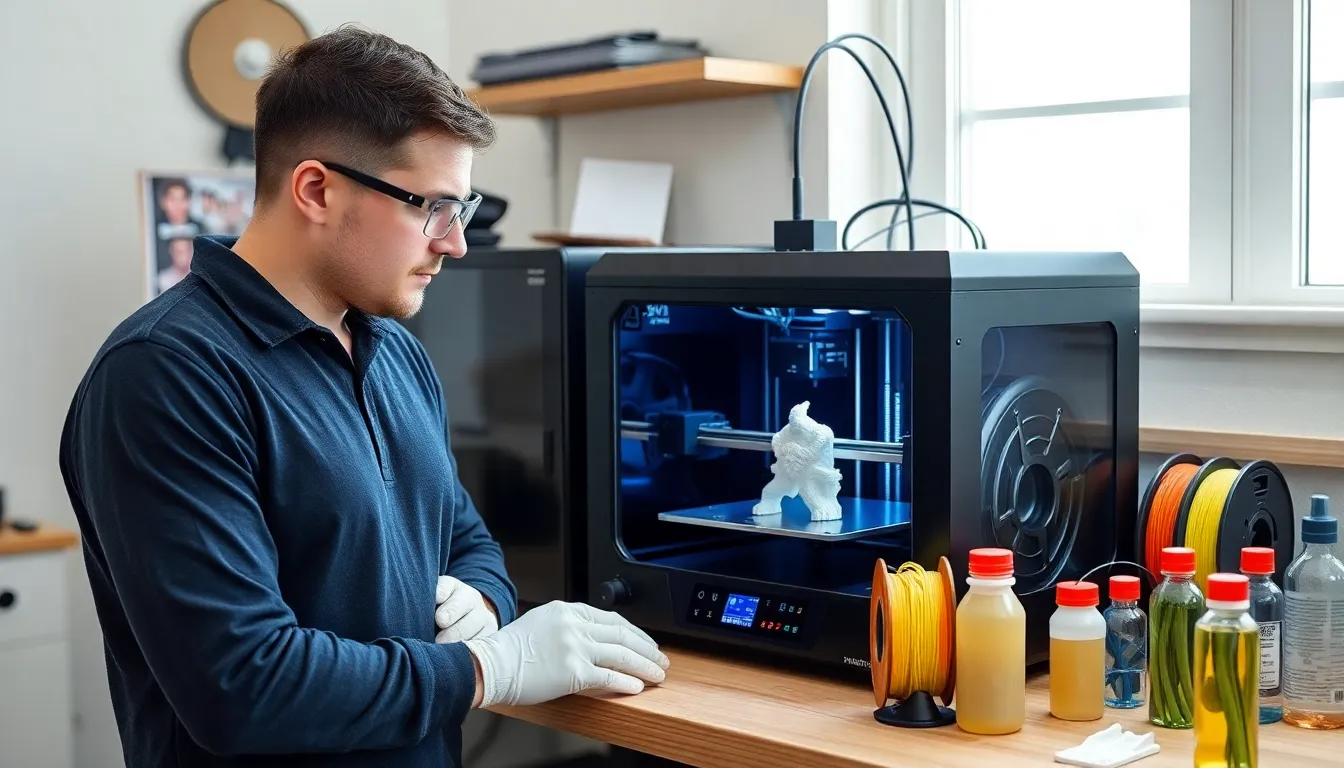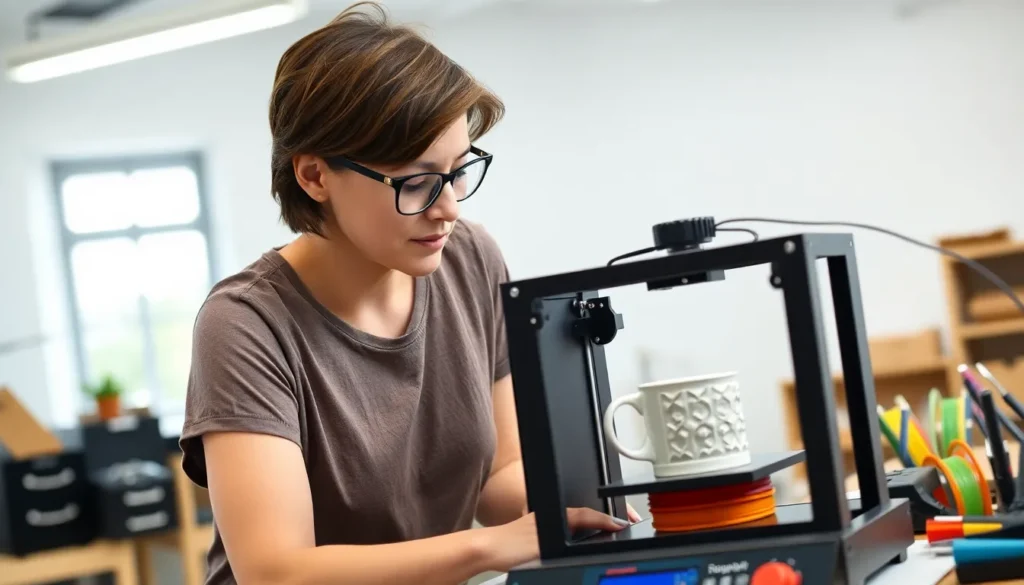Table of Contents
ToggleIn a world where imagination knows no bounds, 3D printing stands as the superhero of creativity. Picture this: you can turn your wildest ideas into tangible objects faster than you can say “layering technology.” Whether it’s a quirky coffee mug or a prototype for your next big invention, 3D printing makes it all possible—without the need for a magic wand.
Understanding 3D Printing
3D printing is a revolutionary technology that transforms digital designs into physical objects. This process involves additive manufacturing techniques, which layer materials to create intricate shapes and structures.
What Is 3D Printing?
3D printing utilizes computer-aided design files to produce three-dimensional objects. Printers deposit materials, such as plastics or metals, layer by layer, forming the final product. Common applications include creating prototypes, custom parts, and detailed models. Various techniques, including Fused Deposition Modeling (FDM) and Stereolithography (SLA), enable diverse printing options. These methods differ in their approach to layering, affecting the finish and strength of the printed items.
History of 3D Printing
The roots of 3D printing trace back to the 1980s. Chuck Hull invented Stereolithography in 1986, launching the additive manufacturing industry. Throughout the 1990s, advancements led to new printing techniques, enhancing precision and accessibility. By the early 2000s, 3D printing technology penetrated various sectors, including education and engineering. Open-source initiatives emerged, making 3D printing more widely available. This evolution opened doors for hobbyists and professionals alike, shaping the future of manufacturing and creativity.
Preparing for 3D Printing

Preparation is crucial for successful 3D printing. Understanding the components helps individuals achieve optimal results.
Choosing the Right 3D Printer
Selecting a suitable 3D printer depends on project requirements. Some individuals prioritize affordability over features, while others focus on speed and precision. Fused Deposition Modeling (FDM) printers provide cost-effective options for beginners. Stereolithography (SLA) printers offer finer detail and smoother finishes. Evaluating user reviews and manufacturer specifications aids in making informed decisions. Assessing the print volume capacity also plays a significant role in printer selection. Comparing features helps identify which printer best aligns with the intended applications.
Selecting Materials for 3D Printing
Choosing the right materials enhances the quality of printed objects. Common options include acrylonitrile butadiene styrene (ABS), polylactic acid (PLA), and resin. ABS provides durability and flexibility, making it suitable for functional parts. PLA is biodegradable, easy to print, and ideal for beginners. Resin, while often more expensive, allows for high-resolution prints with intricate details. Understanding the characteristics of each material influences the final product’s strength and appearance. Testing small samples can determine compatibility before committing to larger projects.
The 3D Printing Process
3D printing involves several essential steps that transform digital designs into tangible objects. Understanding these steps ensures high-quality results in any project.
Designing Your 3D Model
Design software plays a crucial role in creating 3D models. Popular programs like Tinkercad, Fusion 360, and Blender help users craft intricate designs. Users must consider dimensions and details while modeling. It’s vital to save designs in a compatible format, such as STL or OBJ. Reviewing software specifications ensures designs accurately translate into printed forms. Creative applications cover everything from toys to functional parts. Emphasizing precision improves print outcomes and reduces the need for adjustments later.
Slicing the Model for Printing
Slicing software converts 3D models into machine-readable code. Programs like Cura and PrusaSlicer are widely used for this purpose. The slicing process involves selecting print settings, including layer height, infill density, and print speed. Influencing the final quality and strength, these parameters require careful consideration. Once the model is sliced, it generates a G-code file, which the printer understands. This step prepares the design for the specific printer model. Adjusting print settings helps optimize results based on material choice and intended use.
Post-Processing Techniques
Post-processing techniques enhance the quality and aesthetics of 3D prints. These steps can significantly improve the final product’s appearance and functionality.
Cleaning and Finishing Your Print
Cleaning the print is essential for achieving a polished look. Removing support structures and excess material ensures that the object looks its best. Users can employ tools like pliers or knives for precise removal without damaging the print. After cleaning, sanding smooths out any rough edges, elevating the surface quality. A gentle wash with water or isopropyl alcohol can help eliminate dust and debris. Applying a primer before painting improves adhesion and further enhances appearance.
Painting and Assembling Parts
Painting enhances the visual appeal of prints. Choosing suitable paints, like acrylics or spray paints, can yield vibrant results. Each layer of paint should dry fully before applying the next for a consistent finish. If prints consist of multiple parts, assembly requires attention to detail. Using glue or screws ensures a strong bond between pieces. Aligning components correctly avoids misfits that compromise the overall structure. Sealing the finished assembly with a clear coat protects the paint and preserves the print’s quality.
3D printing opens up a world of possibilities for creativity and innovation. With the right tools and knowledge anyone can transform digital concepts into tangible objects. By understanding the nuances of different printing techniques and materials individuals can achieve impressive results tailored to their specific needs.
Preparation plays a crucial role in ensuring successful prints. From selecting the appropriate printer to mastering design and post-processing techniques every step contributes to the final outcome. Embracing this technology not only enhances personal projects but also paves the way for future advancements in manufacturing and design. As 3D printing continues to evolve it remains an exciting frontier for both hobbyists and professionals alike.




